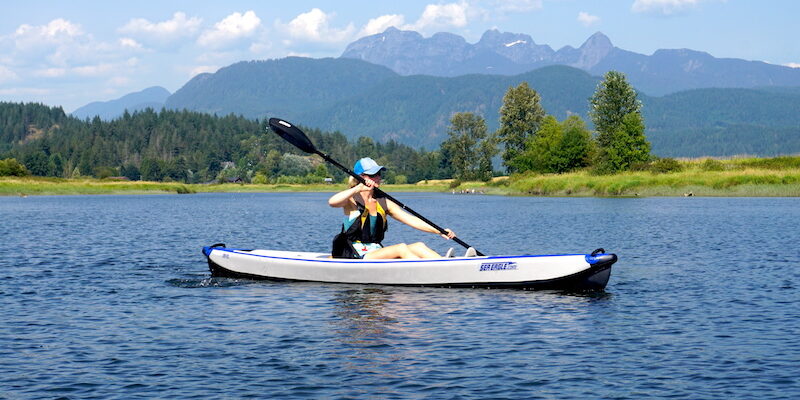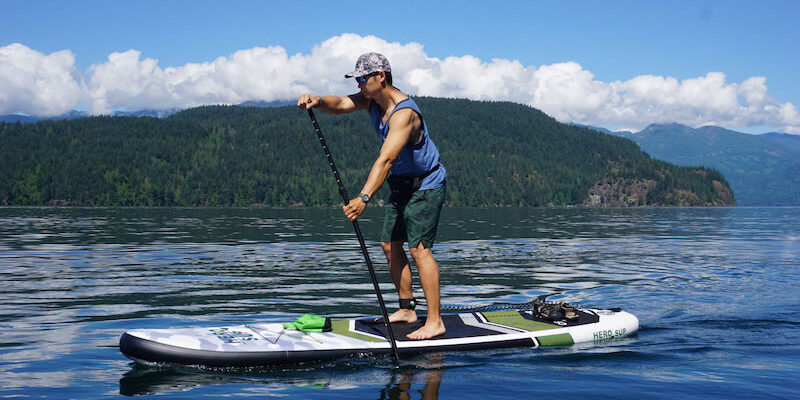If you have fallen in love with kayaking you will not want to stop once the weather turns chilly.
Kayaking in the cold weather can be invigorating, great exercise and a lot of fun.
The most important thing for an enjoyable ride is to be dressed properly for the cold water, the wind and the icy air.
Below are some tips that I have learned over the years from not dressing properly for the cold weather.
Tips for Keeping Warm while Cold Weather Paddling
Tips # 1 – Do not wear cotton!
This is the most important tip to know while kayaking in the cold. I have made this mistake before and trust me it is a bad mistake.
Cotton will soak up the water and hold it against your skin.
If the water is cold and the wind is even colder you are going to freeze. I wore a cotton top underneath a waterproof jacket thinking that I would be okay. Nope – I froze.
It was a bad idea and one I won’t ever do again. My inexperience made for a very unenjoyable and quick kayak trip.
Tip # 2 – Wear layers
Your first layer should be a top that wicks that moisture away from you. I would highly recommend a HydroSkin shirt that is lightweight and comfortable.
It will reflect your body heat back to you while minimizing water absorption. Your second layer needs to be your insulation, so either an insulating sweater or my preference is a comfy fleece.
Your top layer of course is your waterproof jacket and pants. These will protect you from the elements and keep you ultra warm and comfy.
Tip # 3 – Protect your extremities
It is of utmost importance to keep your feet, hands and head dry and warm. If any or all of these are wet and cold your trip will be cut very short – believe me.
- Waterproof booties are essential. If the weather is really cold you may also want to add some water socks for extra warmth and protection.
- A good pair of warm kayaking gloves should always be warm. It is simply not worth allowing your fingers to freeze. My personal favorite that I have used for the past three years are the NRS Utility Paddlers Glove.
- Next is your head. I cannot stress enough how important it is to keep your head warm. If you do not wear a hat, your whole body will be losing heat. I am never out kayaking in the winter or fall without my fleece toque. If you are whitewater kayaking chose a thin layer hat that will fit under your helmet.
What is the Difference between a Wetsuit and a Drysuit?
Wetsuit – A wetsuit is a one piece jumper style suit that basically traps in our body heat and keeps us warm.
They are very popular with kayakers and are usually worn as a base layer with extra insulation on top.
These are best used in moderate weather where the temperature is 50 degrees or higher.
A wetsuit is an extremely handy piece of kayaking gear that many paddlers swear by.
Drysuit – A drysuit is usually made with Gore-Tex and will not only keep the heat in but will also keep the water out.
If you wear insulating layers under your drysuit you will be completely dry and very toasty. A drysuit is an excellent piece of paddling wear to own but they are also highly expensive.
Unless you are an extreme kayaker who likes to paddle in very cold weather you will likely not want to spend the money on one. For most of us recreational kayakers the standard wetsuit will work just fine.
Final Thoughts on Cold Weather Paddling
By wearing the right kayaking gear there is no reason to stop kayaking when the weather turns cold or in harsh environments.
If the water still moves, we can still paddle. The simple trick is to stay warm and dry.
Check out our reviews on popular kayaking gear.


Hi,
I received my SeaEagle 380x two weeks ago and tried it on a lake with my boyfriend. I put the directional stabilizer since the lake was quiet. The paddle was awesome, such a pleasure, it tracks very well, goes at a reasonable speed, from what I have seen so far, when both paddling, it goes at the same speed as a hard hull kayak. I will have to measure and time to compare, but it was really a pleasure. We are both very tall, 6’1 and 6’9 and we fit easily in the boat. I can’t wait to go back on the water. I plan on paddling the Missouri River next spring or fall with it. Had anybody done it yet with an IK?
Beatrice